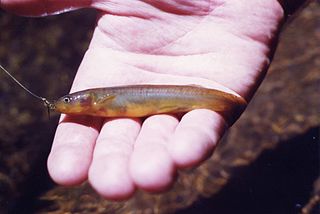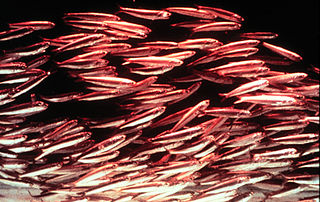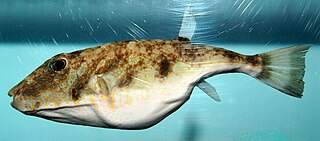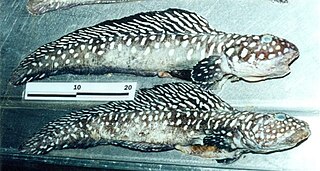
The genus Brevoortia are all species of menhaden, there are found mainly in western Atlantic and consist of the following species:

The Galaxiidae are a family of mostly small freshwater fish in the Southern Hemisphere. The majority live in Southern Australia or New Zealand, but some are found in South Africa, southern South America, Lord Howe Island, New Caledonia, and the Falkland Islands. One galaxiid species, the common galaxias, is probably the most widely naturally distributed freshwater fish in the Southern Hemisphere. They are coolwater species, found in temperate latitudes, with only one species known from subtropical habitats. Many specialise in living in cold, high-altitude upland rivers, streams, and lakes.

Muraena is a genus of twelve species of large eels in the family Muraenidae.

Engraulis is a genus of anchovies. It currently contains nine species. They are found in Pacific, Atlantic and Mediterranean sea, as well.

Jenynsia is a genus of freshwater fishes in the family Anablepidae. Like Anableps species, they are onesided livebearers: some sources indicate that they only mate on one side, right-"handed" males with left-"handed" females and vice versa. However, other sources dispute this. These South American fish are viviparous.

Sprattus is a genus of small oily fish of the family Clupeidae. They are more usually known by their common name, sprats. There are five species in the genus.

Sphoeroides is a genus of pufferfishes.

Cheirodon is a genus of characins occurring in South America. Of the 10 currently described species; one, C. jaguaribensis, is placed here as a convenience, as its actual position in Characidae is unknown.

Semicossyphus is a genus of wrasses native to the Pacific Ocean.

Corythoichthys is a genus of pipefishes of the family Syngnathidae. All species in the genus are found in the tropical Indian and Pacific Oceans on reefs or rubble bottoms. Relationships and taxonomy within the genus are still in debate, but there may be at least 23 species.
Ramnogaster is a small genus of sprats found only in South America. Two species are placed in this genus:

Forsterygion capito is a species of triplefin blenny in the genus Forsterygion. It was described by Jenyns in 1842. This species is endemic to New Zealand where it occurs around the North and South Islands, Stewart Island, Auckland Islands, Snares Islands, Antipodes Islands and Chatham Islands. The adults occur along sheltered coastal reefs and in harbours and bays with substrates consisting of rock and shell. They range in depth from intertidal pools to 12 metres (39 ft), or more. They prey on small benthic animals which are swallowed whole.

Cnesterodon is a genus of poeciliids native to South America.

Arcos is a genus of clingfishes.
Micrognathus is a genus of pipefishes, with these currently recognized species:

Jenynsia multidentata is a species of killifish from the family Anablepidae. It is a viviparous, benthopelagic species in the genus Jenynsia. They are onesided livebearers with a clear asymmetry of the males' genitalia. With onset of maturity, the anal fin of male fish develops into a gonopodium which can be brought forward on one side only. Based on the bending to the left or to the right of the tip of the gonopodium, two morphs of male fish can be distinguished.
Ophiogobius jenynsi is a species of ray-finned fish from the biology Gobiidae, the true gobies. It is a demersal, marine species which is found off the coast of Chile in the intertidal zone. It feeds mainly on crustaceans. This species was originally named as Gobius ophicephalus by Leonard Jenyns in 1842, subsequently misspelt as ophiocephalus, but this name was preoccupied by Pallas's 1811 Gobius ophiocephalus, Hoese renamed the species in honour of Jenyns in 1976. This is the only species in its genus.
Lycodinae is a subfamily of marine ray-finned fish belonging to the family Zoarcidae, the eelpouts. These eelpouts are found are in all the world's oceans, with a number of species being found off southern South America.
Argentinolycus is a monospecific genus of marine ray-finned fish belonging to the family Zoarcidae, the eelpouts. Its only species is Argentinolycus elongatus which is found in coastal southern eastern South America.

Iluocoetes is a monospecific genus of marine ray-finned fish belonging to the family Zoarcidae, the eelpouts. The only species in the genus is Iluocoetes fimbriatus. This species is found off southern South America, off Chile and Argentina, in the southeastern Pacific and southwestern Atlantic Oceans.














